Saturday, December 11, 2010
CORINNA CAUSES CONFUSION
As she explains on her blog, Corinna is causing confusion wherever she goes this week....
GRAHAM IN THE CRAWLSPACE
RAHEEL MUGHAL MSc: Encantado: The Dolphin Men of the Amazon
DALE DRINNON: Khmer Bigfoot [Reposting]
Angkor Thom
KHMER UNITY
 July 22nd, 2006 6:55pm
July 22nd, 2006 6:55pm
When I was younger my father used to tell me folklores of giant apes stealing little girls and trying to breed with tme. And little boys who stayed out late at night would get attack by giant apes. Whatever I thought, until I read and article that they found bones in 1935 in the east asia that might be proof of a bigfoot. But are they still alive? The name for the bigfoot is Gigantopithecus blacki  At the time of the discovery, during the 1930s, von Koenigswald was working primarily in Java, unearthing fossils of human ancestors and their relatives. China's unique fossil shops had already played a major role in tracking down Homo erectus, which lived in Asia between about one million and 300,000 years ago. Homo erectus remains were first unearthed in Java in the 1890s, but pursuit of the source of dragon bones subsequently led to a system of fossil-filled crevices and caverns near the town of Zhoukoudian (Choukoutien), thirty miles from Beijing. There, in 1929, a team of Chinese and Western scientists discovered the first of a series of Homo erectus skulls that became world famous as "Peking man." The original fossils of Peking man disappeared during the confusion of World War II - fortunately, after they were described and cast by anatomist Franz Weidenreich. The war also caught up with von Koenigswald, who was taken prisoner by the Japanese in Java. His precious collection of Gigantopithecus teeth - at that point, the only known specimens of the fossil ape - spent the war years in a milk bottle buried in a friend's backyard on the island. 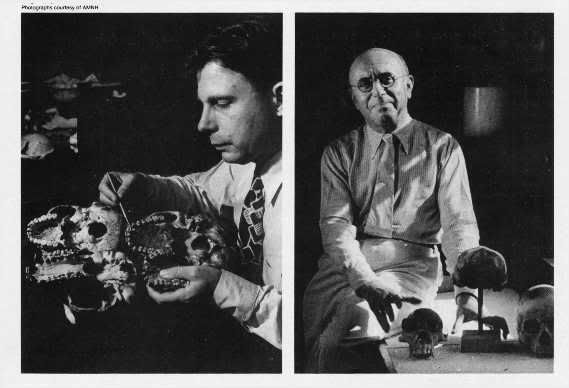 Photographed at the American Museum in the 1940's, German paleoanthropologists Ralph von Koenigswald, left, and Franz Weidenreich, right, pose with the skulls of apes, Homo erectus, and modern humans. The first scientist to discover teeth of Gigantopithecus, von Koenigswald correctly observed that they belonged to an ape, while Weidenreich argued for their humanlike characteristics. 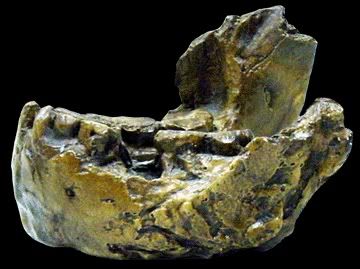 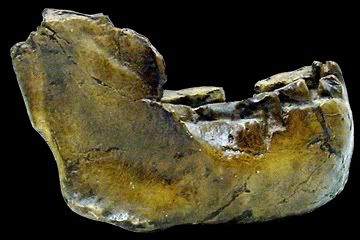 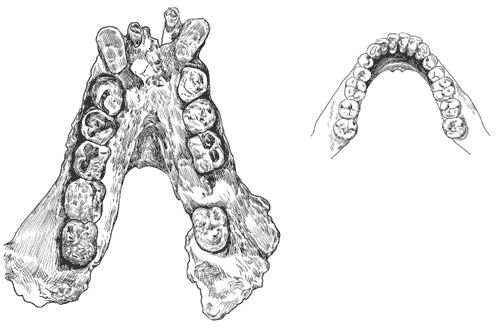 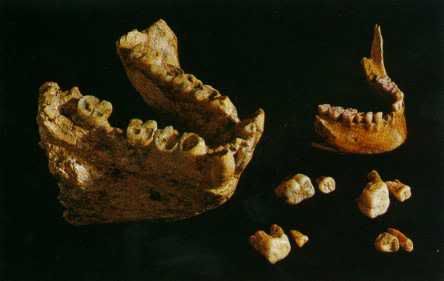 Gigantopithecus compared to human jaw bone  At a Chinese pharmacy in Bangkok, the author (center) and archeologist John Olsen (right) search among the medicinal "dragon teeth" for interesting fossils. 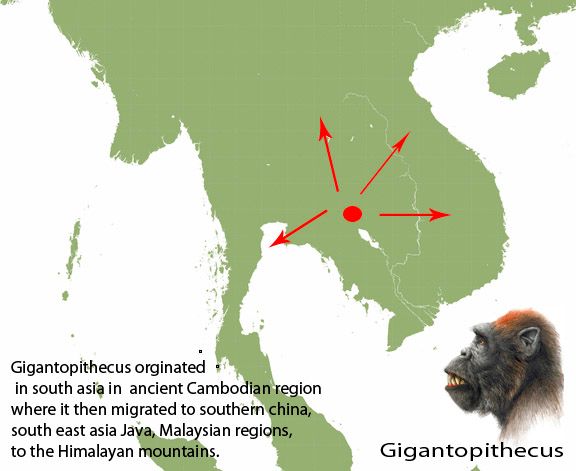 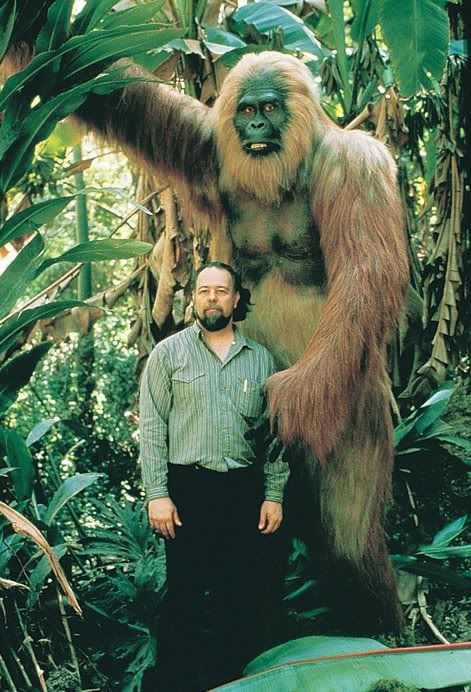 A reconstruction of Gigantopithecus by Russell Ciochon and Bill Munns. Munns is shown here with “Giganto.†Russell Ciochon, U of Iowa 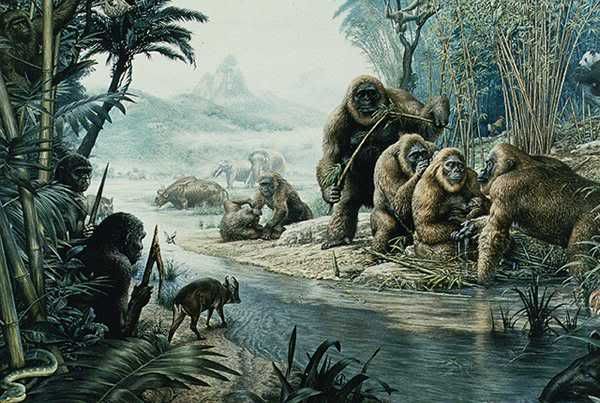 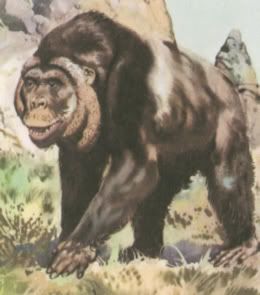    standing about ten feet Gigantopithecus is said to might have lived with humans. 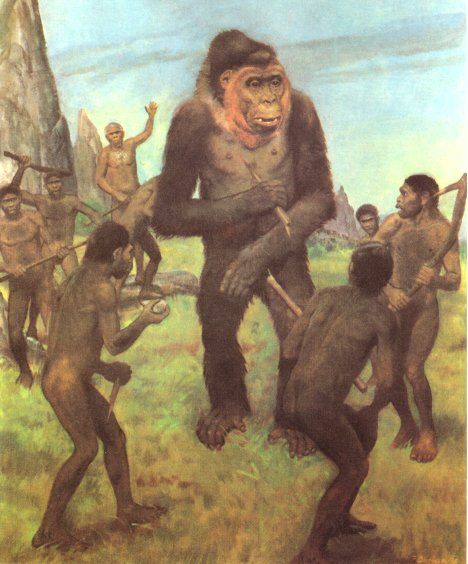 khmer performing as the Hindu monkey god Hanuman, but it could be a dance of a white Gigantopithecus?  Sightings have been seen to this day from Malaysia, vietnam, Cambodia, Thailand and Laos. Some say it was humans (mon-khmers?) building huts and crops that pushed Gigantopithecus to migrate to other regions. Conflicts and fear may have caused them to slowly die out. But even still more sightings have been seen. In Malaysia a team is looking for proof when a logger saw one sitting in his hut. In the Ratanakiri region a herbologist have said to seen one in the jungle. In the vietnam war, viet soldiers have said to be seen one in the junlges running away. Could all these sightings and stories be true, could Gigantopithecus the Cambodian bigfoot be still alive? |
My parents and a group of about 10 other people saw an entire community of them, about 15, 5 or 6 adults and the rest adolescents, and a couple babies hanging onto there mothers.
My parents were hiding out on Phnom Sompov during the Vietnamese Invasion, when they saw a line of these kingkongs just down the mountian heading west about 300 meters away, before they dissapered into the forest. Everyone was on top of the mountian when they saw these apes on flat ground below.
Other parties, saw the same thing at different times in different locations around Phnom Sompov. so there couold be many waves of them passing by.
[Message last modified 07-22-2006 06:45pm by Point_Dexter]
Angkor Wat
"E Pluribus Unum-Many Into One"
Registered: May 2006
Posts: 1703
She also mentioned that the "monkeys" were so big, she thought they were people from the indigenous tribes. She said that they could have shredded her up and eaten her. She described them as walking on two legs upright. I showed her a picture of what KhmerGhost posted and she said that they look similar to that picture.
[Message last modified 07-23-2006 04:44pm by antiquated]
Angkor Wat
From: California
Registered: Jul 2004
Posts: 3026
*heart attack* Those pictures are creepy! >.<>
Khmerghost
Angkor Thom
KHMER UNITY
Registered: Feb 2002
Posts: 664
quote:
Originally posted by Point_Dexter
Asked my parents about them earlier.
My parents and a group of about 10 other people saw an entire community of them, about 15, 5 or 6 adults and the rest adolescents, and a couple babies hanging onto there mothers.
My parents were hiding out on Phnom Sompov during the Vietnamese Invasion, when they saw a line of these kingkongs just down the mountian heading west about 300 meters away, before they dissapered into the forest. Everyone was on top of the mountian when they saw these apes on flat ground below.
Other parties, saw the same thing at different times in different locations around Phnom Sompov. so there couold be many waves of them passing by.
[Message last modified 07-22-2006 06:45pm by Point_Dexter]
Thanks for the story. I've been collecting stories for my reviews. So far your story isn't new from khmers viets and laos, seems alot of people have seen them as soon as they were forced to run to the jungles for cover.
Ratanak Kiri and Malaysia is the hot spot. I've mapped some stories out and it seems to be in the edge of Ratanak Kiri. Very interesting story thanks, I'm going to log it in.
Khmerghost
Angkor Thom
KHMER UNITY
Registered: Feb 2002
Posts: 666
quote:
By the way, has there been any Giganto. fossils ever found in Cambodia?
They've found some fossils in Siem Riep market and Bangkok. The first fossil was found in China, but they mapped it out and concluded that they were living around the Tonle Sap region fishing and eating. Fossils are really hard to find and since Cambodia just opened to international market it's become the hot spot for research. So many new species that never were seen are popping up left and right.
Bigfoot fever erupted last month when some fish farm workers claimed to have spotted three of the beasts - two adults and a youngster, on the edge of a forest reserve in southern Johor state.
Their improbable tale was lent some authority soon after when an Orang Asli - an indigenous ethnic group known for their expertise in the jungle, also said he had stumbled across one of the legendary ape-men.
"He saw the creature which was hairy and brownish in colour, it was about 12 feet [four metres] tall," Johor National Parks director Hashim Yusoff said.
"It was not aggressive, but the Orang Asli was startled by the creature and ran away.
"My personal feeling is that there is a possibility it could be what we call in Malaysia the 'mawas' ... more of a primate.
"But we don't deny the sightings," he said, insisting that the Orang Asli "do not lie".
"We've got to prove it and we've got to do it scientifically."
Quest
Wildlife authorities have embarked on a quest to verify the claims, and are considering mounting camera traps to capture images of anything roaming the jungles.
After a month of fruitless searching and interviews with people living near the forests, a telephone hotline has now been set up for members of the public who claim to have seen the beast to relate their stories, Mr Hashim said.
"Our main aim is to identify the information source, whether it is credible or not," he told AFP.
The Malaysian press has given prominent coverage to reports of sightings, including some which date back decades, and printed photographs of supposed footprints - vague impressions in the mud and leaves on the jungle floor.
Johor is home to large tracts of jungle, including its famed Endau-Rompin National Park, and unconfirmed sightings of large creatures surface periodically there.
Proof elusive
Former zoologist Amlir Ayat said this week that he had come close to finding proof of the existence of Bigfoot five years ago after villagers claimed to have shot a huge hairy creature in the jungles of neighbouring Pahang state.
"The creature fell to the ground with a great thud and the villagers took to their heels. Later, when they returned to check if it was dead, they found the body still lying there," he was quoted as saying by the New Straits Times.
Dr Amlir said he was only told of the shooting a year later. He and the villagers mounted a search for the remains of the creature but found none.
"By then, loggers had moved into the site and cleared the ground," he said.
"The evidence was gone."
Vincent Chow, an adviser to Johor's Malaysian Nature Society who has been lobbying the government to look into the claims, dismissed the sceptics who insist the "sightings" have been manufactured to lure tourists to Johor.
"There's a lot of excitement, a lot of people are coming in with their own stories," he said.
Sightings of mythical ape-like creatures have been reported in wilderness areas all over the world.
They are known as Bigfoot or Sasquatch in the United States and Canada, and yetis in the Himalayas.
____________________________________________________
The two remaining types of ABSMs, the Neo-Giants and the Meh-Tehs, present us with problems altogether different from any that we have so far encountered. Here, we come to the real core of the matter. These are the Dzu-Teh, Tok, Gin-Sung,
[paragraph continues] Sasquatch, Oh-Mah, Sisemite, Didi, Mapinguary type on the one hand, and the Meh-Teh, Golub-yavan on the other. We may well call these the "Inevitable No-men."
What could the Neo-Giants be and why should they have the apparently extraordinary distribution that they are alleged to have? At first both questions sound unanswerable but both are really amenable to very simple suggestions. Some years ago (1937) one Dr. von Koenigswald was searching through bottles of old fossil bones and teeth in a Chinese apothecary's store in Hong Kong when he came across a human molar tooth that was at least ten times in volume that of any ever grown by a man. And thus started the affair of what has been named Gigantopithecus, an enormous something, that once inhabited south China and left its bones in limestone caves. The controversy about this creature has been extensive and intense. Dr. Koenigswald's associate, Prof. Weidenreich, named the tooth Gigantopithecus, which means the giant "monkey" or by license "ape," rather than Gigantothropus or the Giant Man, because he was a very conservative and ultra-cautious soul. However, even before further remains of the brute had been found, other leading scholars stated that it was misnamed and was definitely a Hominid. [I had the privilege of examining the tooth all one afternoon in the American Museum of Natural History, and comparing it with the molars of all manner of men, current and fossil, and with apes, and for what my opinion is worth, it is certainly most strongly hominid.]
The tooth remained a ghastly enigma until 1956 when a Chinese farmer by the name of Chin Hsiu-Huai dug guano out of a cave in a mountain named Luntsai in Szechwan and spread it on his field. In this was found a part of a jaw with teeth of the same kind. Dr. Pei Wen-Chung, doyen of Chinese anthropologists, set up a prolonged search and found some fifty more teeth and, allegedly, a number of limb bones of the creature. He said that these indicated that it was a 12-foot tall, bipedal, carnivorous [sic] ape, than which there could hardly be a longer list of non sequiturs. Its teeth are utterly human, not just humanoid or hominid; if it walked erect, it was not an
ape—not at that size and weight; and if it was carnivorous [which its teeth do not at all indicate] it was, again, not an ape as that seems to be just about the only distinguishing thing about the diet of that group—they are all profoundly herbivorous, though gibbons will take insects.
The other question debated about this brute has been whether [if it is not an ape but a Hominid], it belongs with the Pithecanthropines of North China and Java—to wit: Sinanthropus, Pithecanthropus, and the giant Meganthropus. This is not really very important to us but the manifest fact that it was a Hominid and not a Pongid is so, and leads to certain potent observations. If it was really that size, or even over six feet tall, it must have been a terrestrial creature, and if it was an ape it would have walked on all fours like the gorilla. Nothing that size can travel by treetops. If it was not an ape, it started out with the hominid type of foot, which is what is called plantigrade, and neither it nor its ancestors ever needed to develop a specialized great toe, which was opposed and worked like a thumb. Thus, this creature, primitive as it may have been, probably had a very human type of foot on which to support its immense bulk. Whatever it was, it lived in what is now southern China.
Now let us look at Map X. This area is a part of Orientalia, and is today subtropical. The mountains that surround it are those of the Indo-Chinese Massif and of the Szechwan Block. These areas are the lands of the Dzu-Tehs, Toks, Kung-Lus, and Gin-Sungs—the huge, furred "bear-men" or "men-bears" of ancient Chinese, Mongolian, and Tibetan legend and of current ABSM lighters. But then comes another thing. What else lives in and previously lived in this area? This is the land of the Metasequoia, of the raccoons called pandas, of certain curious little insectivorous mammals, of several odd amphibians, and of numerous invertebrates including a lot of most rare and odd parasitic forms. And where else, if anywhere, are any of these or their only relatives found today? In the northwestern part of North America!
There is still a continuous causeway of mountains from Szechwan all the way [to the west of China proper] to and
through Manchuria to eastern Siberia. Because of increasing altitude toward the south (see Chapter 18), this is clothed in the same type of montane forest all the way. The same kinds of forest start again on the other side of the paltry Bering Strait, in Alaska, and continue on down in an almost unbroken chain to Tierra del Fuego at the very bottom end of South America. Moreover, sometime during the recent ice-advances and retreats, all manner of Siberian animals crossed over to the New World—like the Brown Bears, the Moose, the Elk, and others; and finally, the Amerinds, and then the Eskimos, did so too. Why on earth, should or could not a large sub-hominid also have done so, and simply by following the richly stocked montane forests all the way? That low temperatures could have prevented or even dissuaded them from doing so is just not valid, for, if the Dzu-Tehs are their living representatives, they can travel in snow without any trouble, and crossing the Bering Straits [even without a land-bridge due to alterations in sea level or elevation of the land], is no problem, for you can always walk across the ice in winter. It looks, therefore, very much as if Bernard Heuvelmans might have been right when he suggested that the largest type of ABSM in northern Orientalia could be a descendant of the Gigantopithecus, and the bolder his suggestion seems now, when it is realized that at that time (1952) the consensus was that that creature was an ape.
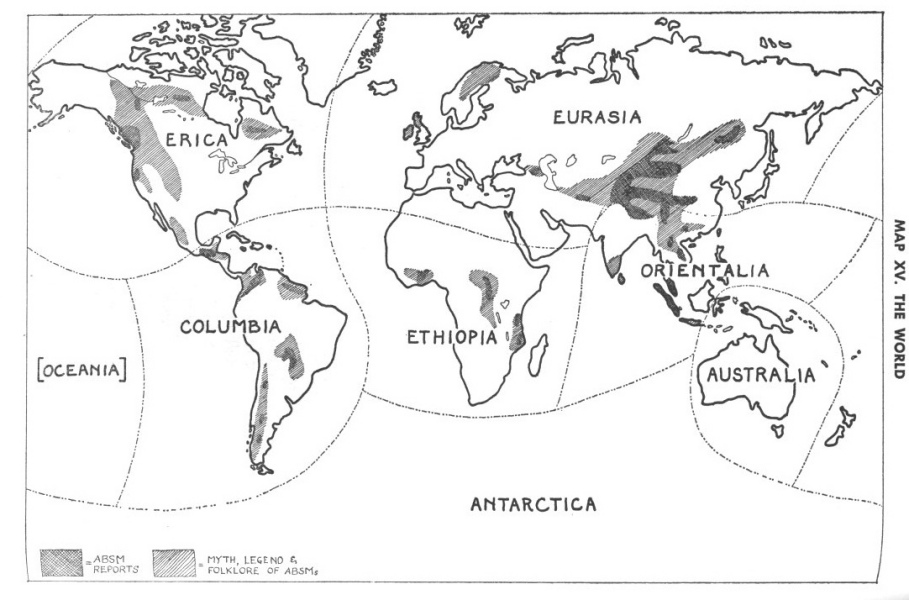
NATIONAL GEOGRAPHIC: The Ten Weirdest Animals of 2010

2010's Weirdest Animals
National Geographic has selected the 10 Weirdest Animals of 2010, including the pictured 'Yoda Bat,' the T. Rex Leech, and the new Purple Octopus. View the gallery here.
OLL LEWIS: Yesterday's News Today
Yesterday’s News Today
http://cryptozoologynews.blogspot.com/
On this day in 1982 in a peace protest at Greenham Common, UK, 30 000 women joined hands around the perimeter of the American air base; it didn’t really make much difference.
Before the news, though: Jon told me that I should probably explain, for people who might not be up on their British history, who Llywelyn ap Gruffydd was. Llywelyn the Last, as he is also known, was the last Welsh prince to survive the incursion of the English king Edward into Wales. After his death his head was paraded through London wearing a crown made of ivy in what the English thought was a hilarious critique of Merlin's prophecy that a Welshman would one day be crowned king of England. Thinking that they had averted this possibility with their childish display they would have probably been kicking themselves if they had known that this prophecy would come true at the end of the Wars of the Roses when Welshman Henry Tudor became king Henry VII. So now you know.
And now, the news:
Wild man elusive, Beijing man foun
The bizarre tale of the rat which took a cigarette..
Red Sea Shark Attacks: Killing Spree Puzzles Scien...
Anthropology a Science? Statement Deepens a Rift
Cat video of the day:
http://www.liveleak.com/view?i=c12_1239886120


















